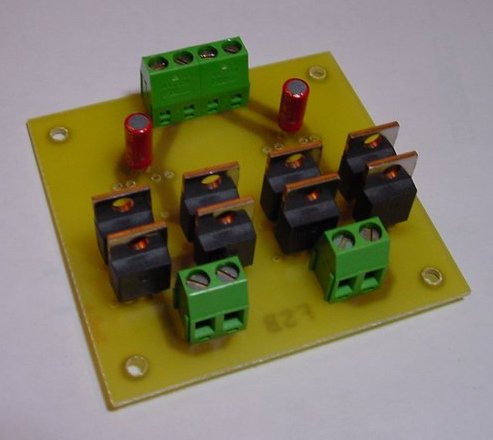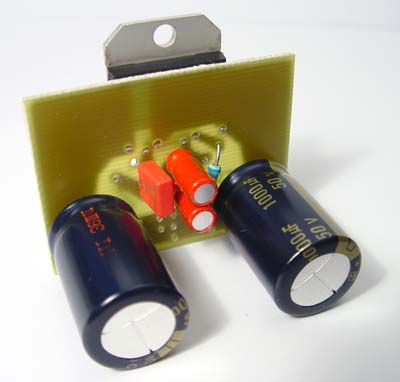| Chill-amp |
Updated on: Februari 5th 2006 |
| For almost two years, I have been experimenting with 'gainclone' amplifiers. Gainclone amplifiers use opamps instead of the tubes and transistors that can be found in most amplifiers. |
|
This project is superseded by the Chill-amp II project! |
| Opamps ??? I thought they sounded bad ??? |
|
Yes, I thought that too. My interest in trying something with opamps was born when I saw the raving
reviews
of the
Gaincard
of
47 Labs
and the article
"Op-amps are More Fun than Tubes". Soon, I found
some pages describing various clones of the gaincard (called gainclones). The most interesting was a forum dedicated to making
amplifiers with opamps, the
Amp Chip DIY Forum. I found an interesting circuit made by Thorsten
Loesch there, an inverting gainclone. With this circuit, I made my first amplifier, the
Thor-amp. That amplifier sounded quite sweet
and for a long time I was quite happy with the result! After a while, I found some limitations. I tried the non-inverted
opamp circuit, and found it to be superior to the inverted circuit in some ways
(especially near the maximum volume :-).
After a bit of tweaking of the non-inverted circuit, the Chill-amp was born...
|
| Chill-amp concepts |
|
| The schematics |
The circuit is very simple and consists of one power opamp per channel with a handful of resistors and capacitors.
The amp is built dual mono. The amplifier circuit  The supply |
| PCB's |
Two PCB's are available for the Chill-amp: The supply PCB  The amplifier PCB The amplifier PCB's cost only EUR 10,00 for a pair, the supply PCB's EUR 12,00. Four PCB's cost EUR 20,- International shipping is 5 euro. Mail me for more information!!! |
| Speakers |
| A very important topic regarding gainclones is the choice of speakers. Thorsten recommends speakers with 90 dB/W or higher efficiency. Also, speakers with 8 ohm input impedance (or higher) are better. This amplifier is not so suitable for speakers with an impedance below 4 ohm. The Chill-amp delivers about 40-50W. I use the Chill-Amp with Tannoy SGM-12X speakers (93 dB/W). This pair of equipment is usually more than LOUD enough for me!!! :-P |
| The sound |
| The sound of the Chill-amp is in my humble opinion quite special. It is fast, clear and smooth. It can even be a bit warm, with the right music and source. You could describe the sound as a mix between tube amps and solid state amps. It has something of the warmth of tube amps and the control of solid state amps without the grainy and lifeless character. The bass is quite tight. Also, the stereo placing is good. All in all, the amp makes music more interesting for me... :-P |
| Photos |
|
Regrettably, at this moment no photos are available of the Chill-amp! It looks similar to the Thor-amp, as it is built
in the same 19" rack. I plan to build a smaller enclosure for the Chill-amp. I will make
some photos when it is finished! |
| Datasheets |
|
|
| Build your own Chill-amp!!! |
| Finally, the DIY Chill-amp page is finished! |
| Links |
|
47 Labs, the company that makes very inspiring audio designs! Amp Chip DIY forum, forum about Gainclones and non-oversampling DACs Audio-cube, page about 47 Labs and other high-end products Nick Whetstone's gainclone page Craig Frasers gainclone page Maartens gainclone page Richard Murdeys gainclone page |
|
Show the DIY Chill-amp page please!!! Show the other audio projects! |